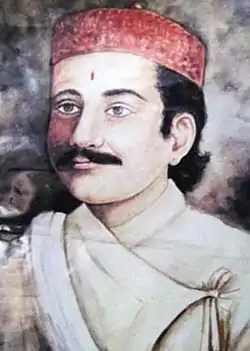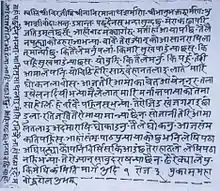Bhanubhakta Acharya
Bhanubhakta Acharya was a Nepali poet, translator and writer. He was the first writer to translate the great epic Ramayana from Sanskrit to Nepali. Despite having other contemporary poets in the country during his time, he is revered and honoured with the title of Aadikavi of the Nepali language. His poems were later published by famous poet Motiram Bhatta.
Aadikavi Bhanubhakta Acharya | |
|---|---|
 First poet of Nepali language, Bhanubhakta Acharya | |
| Native name | भानुभक्त आचार्य |
| Born | 1814 (1871 B.S.) Chundi Ramgha, Ghasikuwa Tanahu District, Kingdom of Nepal |
| Died | 1868 (1925 B.S.) Setighat, Tanahun District |
| Occupation | Poet |
| Language | Nepali language |
| Nationality | Nepali |
| Citizenship | Nepali |
Early life
Bhanubhakta Acharya was born on 29 Ashadh 1871 B.S. (July 13, 1814) in Tanahu district of Nepal in a village called Ramgha. Acharya was born to a Brahmin family and received education at home from his grandfather. His father Dhananjaya Acharya was a government official and was eldest of all brothers.
Education
Bhanubhakta received his education of Sanskrit at his home by his grandfather and later in Varanasi.[1][2]
Career and writing
He is honoured with the title of Aadikavi (आदिकवि)for the contributions he made in the field of poetry and Nepali literature and for specially translating Sanskrit Ramayana in simple nepali language which became popular among laymen. Every year, his birthday is celebrated as Bhanu Jayanti(13 July) when various literacy programs are organized to him.

South Asian languages including the Nepali language were limited mostly to an oral medium of language dissemination at the time with little written context and literary influence. As most of the written texts of South Asia were dominated by Sanskrit, it was mostly inaccessible to the general populace. As the Brahmins were the caste who excelled as teachers, scholars and priests, the access to all of the religious scriptures and other literary works was only limited to them and few who also could receive education and understand Sanskrit. Many poets had written poems in Sanskrit while Acharya started to write in the Nepali language which not only popularized the language but also gained him acceptance from the Rana Rulers. Acharya's benevolence towards Ram’s heroic exploits brought in him an urgency to make his tale accessible to the people who spoke Nepali. Since most of the people did not understand the Sanskrit language, he translated the epic into the Nepali language. Preserving the lyrical narration style of Ramayana his translations are believed by scholars to carry the same lyrical essence "Bhava and Marma" that rather than sounding like a poem sounded more like a song without distorting the regional influence or the inner meaning of the Ramayana.
He did not receive any western education nor was familiar to foreign literature which kept his work and experiential journey original to the vernacular literary system and brought strong Nepali flavour to his works. The key features of his writings were simple yet strong with a sense of religion, sense of simplicity and the warmth of his country that not many of other poets had been able to be compared to.
Belonging to a wealthy family, he never had any financial trouble and had an unremarkable life until he met a grass cutter who wanted to give something to the society so he could be remembered after death too. The grass cutters words were what inspired him to do something that would leave a mark in the society. He wrote two masterpieces in his life among which, one is the Bhanubhaktey Ramayan and the other is a letter he wrote in verse form to the Prime Minister while he was in prison. He was made a scapegoat and sent to prison due to some misunderstanding in signing the papers. In prison, his health deteriorated and he was given false hopes of being set free but his case was not even heard. So, he wrote a petition to the Prime Minister requesting his freedom, which later became one of his great works.He not only won his freedom with his poem but was also given a bag of money (He wrote in the same language the then prime minister want to force the public to use). When he died in 1868, he did not know he would one day be one of the most revered poets of Nepal. His creation, however, was not published and he died without receiving credit for his contribution. His works were published by Motiram Bhatta in 1887 after he found the manuscript and took it to Benaras, India for printing. One of Acharya’s works is well known for its colourful, glowing praise of Kathmandu valley and its inhabitants. Although he is one of the most celebrated and revered poets of Nepal, his works are not as famous as other poets in the history of Nepali literature.
Recognition of him
Bhanubhakta Acharya is revered and honoured with the title of Aadakavi (The First-ever Poet) for the Nepali people of Nepal. Motiram Bhatta, first referred to him as Adikavi while writing Acharya’s biography in 1981. He clarifies that Acharya is not called Adikavi because he was the first poet in Nepal but he deserved the title as he was the first poet who wrote with an understanding of the marma (inner essence) of the poetry.[1][2][3]
Bhanu Jayanti
Bhanu Jayanti is a celebration of the birth anniversary of Bhanubhakta Acharya. It falls on the 29th day of the month of Ashad according to Nepali calendar. It is celebrated every year by the Government of Nepal and Nepalese people as well as by the Nepali speaking people around the world. cultural festival, prevalent among the Nepalese around the world in the remembrance of Bhanubhakta Acharya's birthday anniversary. It is generally celebrated in the 13th of July or the 29th day of the Nepali month of Ashadh.
Every year Bhanu Jayanti is celebrated as a mega event with literary seminars, and programs and amid a remarkable presence of Nepalese writers, novelists, and other literary figures/enthusiasts.[2][4][5][6]
Gallery
 Statue of Bhanubhakta Acharya at Chundi Ramgha
Statue of Bhanubhakta Acharya at Chundi Ramgha Bhanu salik at Nepal Academy
Bhanu salik at Nepal Academy Aadikavi Bhanubhakta Acharya
Aadikavi Bhanubhakta Acharya Letter of Bhanubhakta Acharya to his son (1858)
Letter of Bhanubhakta Acharya to his son (1858) Statue of Bhanubhakta Acharya at Chowrasta, Darjeeling
Statue of Bhanubhakta Acharya at Chowrasta, Darjeeling
References
- Ācārya, Naranātha; Śivarāja Ācārya; Sāmbkslo thiyoarāja Ācārya & Jayaraj Acharya (1979). Ādikavi Bhānubhakta Ācāryako saccā jı̄vanacarittra. Tanuṅa: Naranātha Ācārya. OCLC 10023122.
- "Adikabi Bhanubhakta Acharya". Kathmandu: Boss Nepal. Retrieved 2019-02-22.
- Bishnu K.C. (2006-07-14). "Bhanubhakta: The First Poet Of Nepali language". Oh My Newsl. Retrieved 2019-02-22.
- "Development Boards for Kami, Damai, Sarki announced". Darjeeling. 14 July 2016. Retrieved 2019-02-21.
- "PM Oli urges new generation to follow ideals of Bhanubhakta". Kathmandu. 13 July 2018. Retrieved 2019-02-21.
- "Morning procession to mark Bhanu Jayanti". Kathmandu. 13 July 2018. Retrieved 2019-02-21.
External links
- Bhanubhakta Acharya: Personalities of Literature from Nepal
- Books about Bhānubhakta Acharya, in Nepali
| Wikimedia Commons has media related to Bhanubhakta Acharya. |